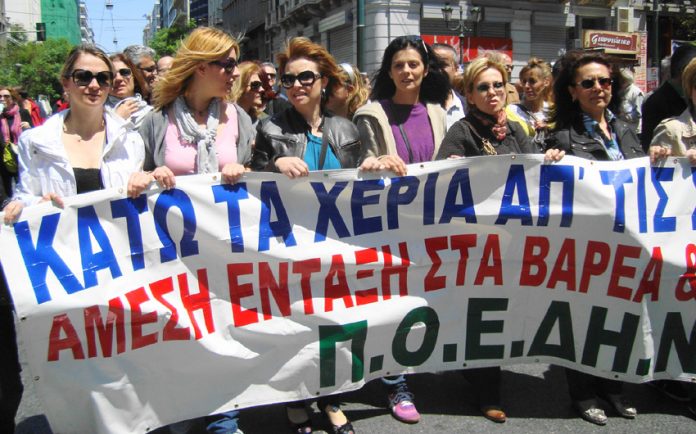ACCORDING to the trades unions, the Greek one-day general strike was solid, with hundreds of thousands of workers taking part in demonstrations throughout the country.
In the industrial areas of cities and especially in refineries, engineering, energy and telecommunications the strike was total.
The strike was also huge on the railways.
The Athens metro and bus system operated 9.00am to 9.00pm to facilitate workers’ participation in rallies and demonstrations.
In the public sector there was a 100 per cent strike in electricity and mines, as well as in local government, civil service, health and education.
Not a single ship sailed from the Greek ports, and there was again a total strike in the media with no papers printed and no news or current affairs programmes on radio and TV.
In Athens over 50,000 workers, students and youth heeded the call of several trades unions and of the Co-ordination of Trades Unions, and staged their own demonstration through the city-centre.
Noticeable were the participation for the first time of sections of the working class (local government, teachers, health, judiciary staff and others) as well as professional associations (doctors, lawyers) who usually side up with the GSEE (Greek TUC) bureaucrats.
Workers carried several banners with helicopters painted on, accompanied by slogans calling for the government and the prime minister to get on the chopper and disappear.
Workers chanted continuously slogans for the kicking out of the ‘junta’ of the International Monetary Fund, European Commission and European Central Bank and the hated austerity measures Accord with the current Yiorghos Papandreou government.
The front banner of the march, carried by workers of the local government trade union POE-OTA, proclaimed: ‘We long to see who will be the first to get out on a chopper’.
Workers kept up shouting ‘oust!’, meaning ‘get out!’, throughout the march.
A large contingent of immigrant workers took part in the march and they were shouting slogans in support of the Arab Revolution.
Grigoris Simos, a young refinery worker (see photo), spoke to the News Line stating that he and his fellow refinery workers will be on strike once again next week, despite the Courts’ repeated rulings that their strikes are illegal.
At a crossroad, the march met up with the meagre 1,500-strong march of the GSEE and of the ADEDY (public sector trade unions), and immediately and spontaneously workers started shouting ‘you scum bureaucrats’ to the GSEE-ADEDY leaders.
Throughout the march to the Vouli (Greek parliament) large chunks of demonstrators were flanked on both sides by fully armed and ready riot police.
The march did not stop at the Vouli but carried on towards the central building of the University of Athens.
When the last contingents were leaving the square in front of the Vouli building, the riot police launched a vicious premeditated attack on the demonstrators.
They threw scores of noise and lightning bombs and tear gas canisters on the crowd and then attacked, through the intense fumes of the teargas, with their truncheons held upside down so that demonstrators were hit by the metal end of the truncheon.
Workers and youth fought back, setting rubbish bins on fire to lessen the effect of the teargas, and throwing stones and some petrol bombs at the riot police, who went berserk.
It was then that, according to eye-witnesses, Yiannis Kafkas was hit by a truncheon on his head.
Earlier, the KKE (Greek Communist Party) had staged its own rally and demonstration in Athens with thousands participating.
Large rallies and marches were held in all the main Greek cities.
The Greek Trotskyists of the Revolutionary Marxist League intervened with their newspaper in the march calling for the overthrow of the government and revolution after the declared bankruptcy of capitalist Greece, and the building of a mass revolutionary party.
Last Wednesday’s general strike and marches revealed the workers’ determination to get rid of the government and of the IMF-EC-ECB Accord.
It also demonstrated the hatred of the Greek working class and youth against the treacherous trades union bureaucracy which is being isolated; yet, it holds under its claws the most powerful trade unions, such as electricity and mines, energy, telecommunications and others.
The march also exposed the ‘radical’ trade union leaders of the Co-ordination of Trades Unions who once again led a huge and revolutionary demonstration to a stroll around Athens.
The lack of determined and clear political leadership does not reflect the demand of workers and youth for the overthrow of the government, the EU and the IMF.
